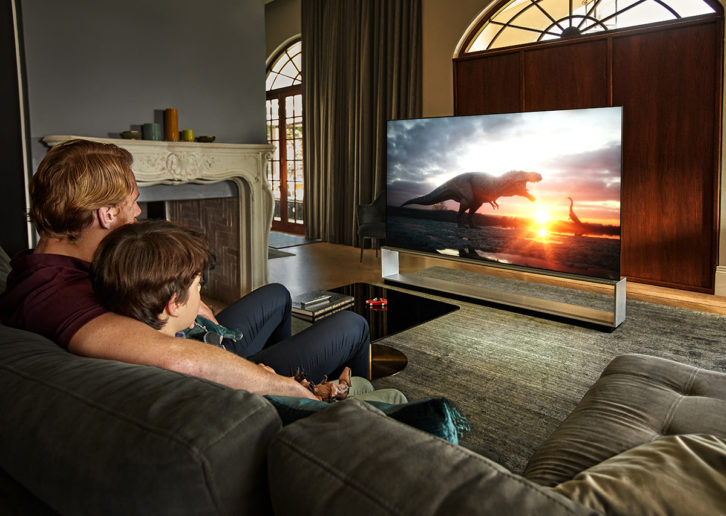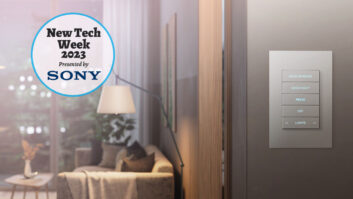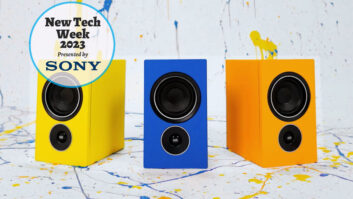
We’ve all heard how technologies like 8K, 5G, and AI are on the verge of changing the home experience, promising its users extraordinary benefits. Our clients have heard this, too, and are no doubt looking to CI dealers — their tech people — for answers to questions such as “What does it mean?” and “When should I buy in?”
To help keep your clients in the loop, we’ve spoken to industry experts about the whys, the whens, and the what’s-taking-so-longs for each of these categories.
8K
For 8K, the “when” has already happened, with 8K televisions and projectors making their tradeshow debuts in late 2018, and more models joining product lines each year. In this case, it is the “why” that comes more into question, as there is no true 8K video content right now, and, even if there were, can viewers even tell the difference between 8K and 4K?
If any of that sounds familiar, it is because it was the same arguments made when 4K began its march toward viewer domination, which it has pretty much achieved, as it is near impossible to buy a television under 50 inches that isn’t 4K.

For a quick tell-a-client summation, 4K is four times the resolution of Full HD, and 8K is four times the resolution of 4K. If any customer is still clinging to their Full HD TV, 8K will offer 16 times the resolution.
Will customers buy into 8K? As of right now, it looks to be on a very similar path to 4K, so it’s likely. “The introduction of 8K is right on schedule,” says Chris Chinnock, executive director of the 8K Association. “There has been a seven-year cycle from full definition to 4K, with that seven years being defined from product introduction to sales reaching 50 percent of all TV sales. The 4K-to-8K transition is following the same path, and we are in year two of 8K right now.”
What that looks like in terms of numbers is that the 8K market was valued at $2.89 billion in 2019 and is expected to reach $15.96 billion by 2025, at a compound annual growth rate (CAGR) of 32.9 percent over the forecast period 2020–2025. Of course, that is assuming nothing happens to slow its progress, like, say, a global pandemic — especially on the supply side. However, Chinnock thinks it will work itself out.
“China had been investing heavily in the latest generation LCD fabs, so there was an oversupply situation that was driving panel prices down in 2019,” he says. “Then the pandemic hits, the factories close down, and all of a sudden there is a supply shortage for LCD panels and prices start to go up because consumers are still buying TVs because they want to watch movies at home. Now, with the economic downturn, TV buying has dropped off significantly, and the panel factories are slowing down and are going back into oversupply mode.
“Some of the market research firms are predicting that we’ll be in a supply shortage mode again in about a year or so, but this is typical of a display panel market.”
Still, even with the supply side handled, Chinnock believes the pandemic has pushed 8K’s development back. “I think the reality is we’re looking at about a six month, if not a year, delay in everyone’s plans for the rollout of 8K because of this pandemic,” he says. “We will see an uptick of 8K TV sales in Q4, which would have been planned for anyway, but we’ve lost a good half, maybe three quarters, of the year in sales. So things will be lower in 2020 than they would have been. And you know that the Olympics was going to be a premier event broadcast in 8K…”
Good point — the first native 4K content was available through sporting events, and that was supposed to be the case with 8K. NHK had committed to presenting the Summer Olympics, including the Opening Ceremonies, and the Paralympic Games in 8K. Now, with the Summer Olympics moved to July 2021, audiences will have to wait another year to see what the new format can do.
Even though the lack of native content is the main impediment to 8K acceptance, the advancements made in AI upscaling may help to make up for that.
“The next-generation, AI-assisted upscaling technologies, which you did not have during the 4K transition, means you can take 4K content and make it look extremely good on an 8K display,” says Chinnock. “You can even take lower-resolution video and make it look decent on an 8K display. So while we wait for native 8K content to come, these great upscaling technologies will allow us to use the content that we have now and make it look better on an 8K display.”
Some of your clients may be holding out for something even better — if 8K is great, won’t 16K be phenomenal? “You could certainly make the argument that acquiring 16K for native content or 8K distribution makes a lot of sense for the same reasons that 8K does,” says Chinnock. “It’s very possible that you’ll see something along those lines on the next seven-year cycle. If it’s not 16K, it could be some other innovation — more dynamic range, more colors. We could move to some different display technologies like Micro-LED, which I’m pretty bullish on. We could even see the first generation of light-field or holographic-like displays start to become interesting in five or six years for sure.”
But who has that kind of time? For customers looking for a new display system right now, 8K is the way to go in terms of both future-proofing and image quality. “As you get larger sized displays, you start to see some of the disadvantages of 4K resolution even from longer viewing distances,” says Chinnock. “You will see some digital artifacts, so having a higher pixel density always increases the image quality.
“From a custom installers point of view, if the client wants the best quality, then they’re going to choose from the top of the manufacturer’s line, and that will be an 8K display.”
5G
Of the three technologies we are discussing here, 5G has promised to be the most disruptive. Also known as the “cable of the skies,” 5G promises ridiculously fast data transmission speeds that will power not just blazing fast media streaming, but also huge leaps in telemedicine, Smart Cities, and the evolution to autonomous cars.
This is another case of the “when” appearing to be now, with cellphone carriers announcing that “5G is here.” The problem is that, despite the proclamation, nothing seems to have changed, so it is easy to understand customers’ confusion over the technology.
The reason nothing seems to have changed is because there are two types of 5G. “We define the two 5Gs as sub 6 GHz and higher than 6 GHz,” explains Bruce Lancaster, CEO of Wilson Electronics. “It’s really two different flavors of 5G. The sub 6 GHz is typically what you’re used to today with the LTE network. The next generation of technology is overlaid on those frequencies. On the other side is millimeter wave or the higher-than-6 GHz 5G — that’s the frequencies that allow huge data throughputs and speeds that are many orders of magnitude greater than what you’re typically used to in LTE.”
According to International Data Corporation (IDC), the number of 5G connections is expected to grow from roughly 10.0 million in 2019 to 1.01 billion in 2023, which represents a CAGR of 217.2 percent over the 2019-2023 forecast period. By 2023, IDC expects 5G will represent 8.9 percent of all mobile device connections.
Of course, those numbers don’t say what kind of 5G will be present, although the main carriers seem to be focusing on specific areas. “The company that’s really embraced sub 6 GHz 5G is T-Mobile,” says Lancaster. “With its acquisition of Sprint, T-Mobile has jumped way ahead in the lead. They now own a tremendous amount of spectrum in that sub 6 GHz frequency, which are easier to deploy, move much further and longer through air, and have the technologies to handle them well established and in place.
“Verizon has bought spectrum in the over 6 GHz 5G frequencies. The challenge with that is those high frequencies just don’t go very far. They don’t propagate through the air more than a few hundred meters. In order to deploy that, you have to be on every block or every other block in major metropolitan areas. That’s really expensive and problematic from city approval standpoint because people don’t want these boxes on every light post.

“What Verizon has deployed so far works well, but the deployment is taking a long time and it’s very expensive.”
Because of its expanded abilities, millimeter wave 5G has the potential to become the internet source in the home, although Lancaster believes that will be based on the situation of the homeowner more than the promise of the technology.
“In very dense urban areas, you could use millimeter wave 5G to replace fixed lines, but, in those environments, you typically have many, many options for fixed lines,” he says. “So it’s the question of what are you replacing it for?
“The rural environment that has less choices and a dramatic need for internet connectivity — because the cable company won’t run a cable down a 5-mile dirt road to support that rural farmer — could be a usage case for the sub 6 MHz 5G to provide internet, but it won’t be millimeter wave because of the propagation issue. The connectivity in the rural market needs to be improved, and 5G low frequency could do that. Millimeter wave 5G is going to be urban, and those areas are already connected.”
Or course, a crowded market doesn’t mean the cellular companies aren’t going to make a play for the home. Verizon is already offering what it calls “5G Home Internet.” As of this writing, it is available in limited areas of Chicago, IL; Sacramento, CA; Los Angeles, CA; Houston, TX; and Indianapolis, IN. If you want to see if it is available for you or your clients’ homes, visit www.verizon.com/5g/home/ and enter in the address of the home you want to check.
So what role does the custom installer play in all this? Same as with any other internet issue. “People want that connectivity,” says Lancaster. “It’s all about penetrating the building. An urban millimeter wave will not penetrate a window, and solutions will be coming soon to propagate those signals from outside to inside. Until that happens, a 4G LTE signal still provides the backbone of the network. And many times even those signals will not penetrate concrete or glass. People want their phones to work inside their home and custom integrators can solve those problems with solutions like ours. As we say, ‘It’s not a bad network, it’s a bad building.’”
5G is coming…slowly, and if you are looking for a sign that will alert you when it finally arrives, Lancaster has a suggestion. “As far as handset technology goes, the iPhone still has not gone 5G,” he says. “It has not been even announced if it will be a millimeter wave-capable phone. When Apple does that — if they do that — that will be a sign 5G has arrived.
“If Apple doesn’t legitimize it, it’s not legit.”
AI
Artificial intelligence may be everywhere right now — whether your customers realize it or not — but we have barely begun scratching the surface of what it can be used for. True, AI does some amazing things behind the scenes, including create some stunning upscaled 8K images on televisions as discussed earlier, as well as recommend products to buy on Amazon and shows to watch on Netflix. (If you feel the Netflix AI is spot on, you are not alone, as the company says 75 percent of what users watch come from those recommendations.)
Beyond marketing techniques, most residential clients experience AI through their virtual assistant system of choice. And, judging by the growth in the market, consumers really like them — according to Futuresource Consulting, shipments of virtual assistants rose 25 percent year-on-year to 1.1 billion units in 2019, with the market on course to exceed 2.5 billion shipments by 2023.
That’s a lot of customer-facing AI, but despite that kind of support, AI hasn’t grown into the sophisticated, thoughtful home control we’ve been promised.
“I think what’s possible from a technical perspective is so far off what we see in the movies,” says Alex Capecelatro, co-founder and CEO of Josh.ai. “What’s interesting is, I look at my father, who grew up before there were computers, and the idea that I can talk to my house and have it do something is magical. That’s science fiction. And the gap from where we were to here doesn’t feel that much bigger than the gap from here to what you see in the sci-fi movies from my dad’s perspective, but — from a technical perspective — that’s a huge gap. I think the technology is moving along. It’s just going to take awhile to get to the point of what people see in the movies.”

Capecelatro and his partner, Tim Gill, launched their AI company five years ago, and although it does not appear that artificial intelligence has developed much over the half-decade, leaps have been made.
“Everything in technology has moved slower than I would have wanted, but also faster,” says Capecelatro. “For example, when we first started no one was doing voice control. People were doubtful that voice would even make sense in the home. But in the last five years that has completely changed to the point where we have clients who are exclusively using voice control that is reliable and works. To that extent, things have moved faster and better.
“On the flip side, though, for years we’ve been talking about a true smart home that knows who you are, sets everything up automatically, and reminds you that it’s going to rain. And here’s an umbrella. That is far from the customer reality today. It’s technically very possible, but I think what it comes down to is that level of AI is so personal and so custom on a home-by-home basis, and we’re not there yet.”
So when will we be there? Next year? The one after that?
“Since starting the company, I would have answered this question the same every year, which is one year from now things are going to look and feel very similar to how they look and feel now — just slightly more refined,” says Capecelatro. “Your comments are going to be registered slightly more accurately. But if you were to aggregate those improvements over a five- to ten-year horizon, that’s where you have some real significant gamechangers. Over the next 12 months, if you find that an AI system doesn’t always do the right thing, that’s all going to incrementally be improving, but things will not be fundamentally different. Five to ten years out? Hardware is evolving, software is evolving, data is evolving. I think things will begin to look pretty different in that timeframe.”
Related: Need to Know – AI & Machine Learning
For AI to work the way we dream it will, it requires the willingness of customers to allow their preferences to be captured. For companies such as Amazon, Google, and Netflix, most people are willing to let their shopping choices, browsing history, and viewing habits be captured and used to make their own experiences better, all while knowing the data could be sold to other companies.
When I spoke to Brad Russell, research director, connected home, Park Associates about AI for our Need to Know series in 2018, he qualified the information users surrender to the reward they would get in return.
“It’s all tied to end user value,” he said. “If the end user perceives these devices and services can do something that’s really valuable to them, then they’ll share the data.”
Of course, there are limits to what homeowners will want shared, impeding AI development, which is one of the reasons why Josh.ai has taken third-party data sales off the table completely, vowing never to share any data they collect, and to keep the majority of the computing local to the home.
“From our perspective, what some clients on the other side of the country are doing doesn’t necessarily apply to what you’re doing,” says Capecelatro. “We think that learning on an individualized basis is both more secure and also more reliable. There are certainly elements that are helpful when you’ve got that country-wide data, but, at the end of the day, I think it’s going to be much more personalized and therefore a much more secure, privacy-focused system that does get better over time.”
What do CI dealers need to know about AI right now? According to Capecelatro, you need to be very aware of the business, even if you are not in it yet. “This is no longer a nice-to-have or a possibility — this is a hundreds-of-millions-of-units-a-year solution that your customers are deploying,” he says. “If you’re not doing it for them, they’re going on Amazon.com and buying it themselves — and living with the consequences.
“It doesn’t mean you need to be deploying it right now if you don’t feel like you’re ready for it, but understand the capabilities, understand how it works, and really keep a pulse on it, because, in my mind, this is one of the fastest evolving places of our industry.”
With AI the possibilities are endless, but there is one thing that is certain — it isn’t going away.
“Every ten years or so, there’s a fundamental change in user interfaces,” says Capecelatro. “They went from the graphical user interface to mobile interfaces, and if voice control is the next evolution, it means everyone will have it. Every home will have it and every device will have it. The indicators suggest this is not just a fad that’s going to fade away — this is here to stay.”
Want more stories like this delivered to your inbox every day? Then sign up for the free Residential Systems eNewsletter here.







